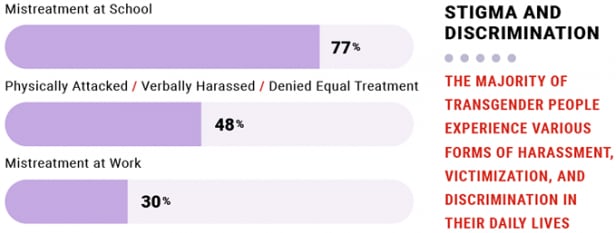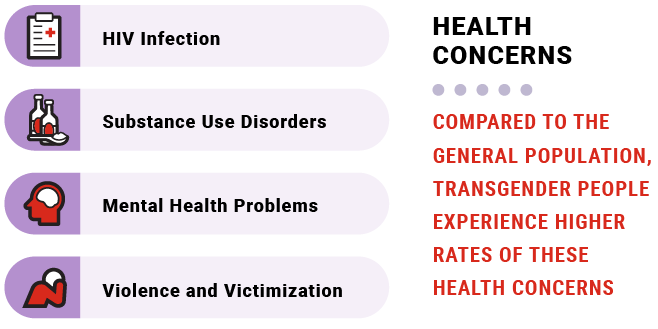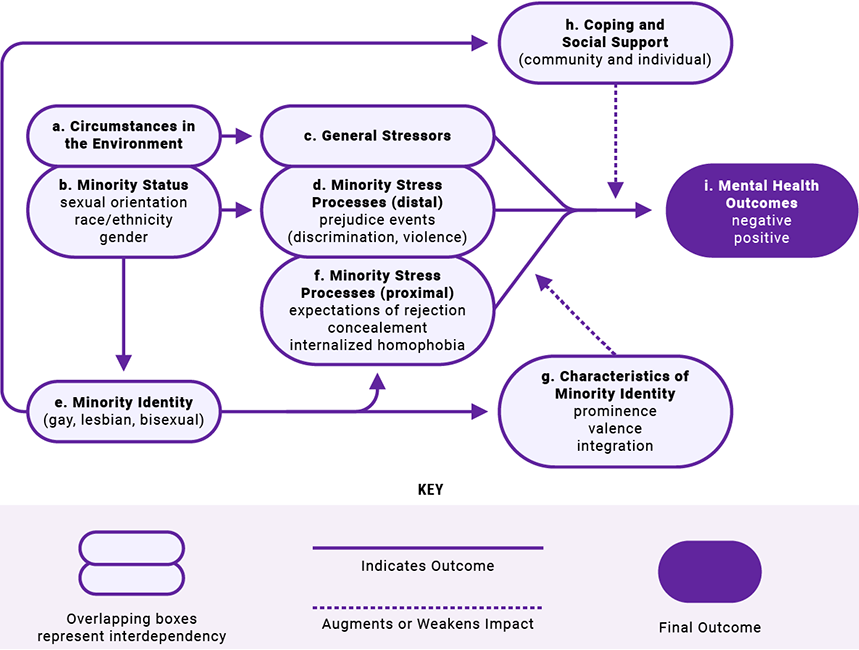Health Care for Black People
Basic Concepts and Terms
From the Patient's Perspective
Watch brief accounts from transgender peopleexternal icon of different ages, ethnicities, and backgrounds discuss their lives and their health care needs. This video provides a look at the diversity of the expressions and experiences of transgender people.
The term transgender has varying definitions across cultures and communities. Most describe transgender people as those who have a gender identity that is different from their sex assigned at birth. Sex assignment at birth is based on external genitalia, whereas gender identity refers to the internal sense of one's gender. Although people use many different terms to describe themselves, in general, a transgender woman is someone who was listed as male on their birth certificate and whose gender identity is female, and a transgender man is someone who was listed as female on their birth certificate and whose gender identity is male. Other people may have a gender identity that is fluid or non-binary; their gender is neither male nor female, or it is a mix of male and female. Sexual orientation, which relates to emotional and sexual attraction to others, is distinct from gender identity; transgender people may have any sexual orientation regardless of their gender identity. For transgender people, the discordance between their gender identity and their assigned sex at birth can cause a great deal of distress. That is why it is important for transgender people to be able to access health care that is patient-centered.
Many—but not all—transgender people make changes to their physical appearance. This is sometimes called gender affirmation. These changes can include modifications to clothing, hairstyles, and mannerisms. Many will change their first name, and they may want others to refer to them by pronouns that correspond to their gender identity. It is estimated that about 60% to 70% of transgender people take hormones and that about 20% to 40% have had one or more gender-affirming surgeries to alter their physical characteristics.1,4 Decisions about medical or surgical treatments depend on personal choice and cost. (See Additional Resources for more on hormone and surgical treatments.)
How many people identify as transgender?
There are two recent estimates of population size ranging from 0.4% to 0.6%. The new estimates are larger than the previous estimate from roughly a decade ago.5,6 The analyses note several reasons that may account for this difference, including a perceived increase in visibility and social acceptance of transgender people, which may increase the number of individuals willing to identify as transgender on a government survey. It is also noted that younger adults aged 18 to 24 are more likely than older adults to say they are transgender.
Transgender Health Needs
The research on transgender people and their health needs is sparse. However, available studies indicate that transgender people experience multiple health disparities due to stigma, discrimination, and unique barriers to accessing quality care.7,8 A brief summary of the barriers to achieving positive health outcomes and the consequences of those barriers is presented below. The purpose of listing these is to build an understanding of the difficulties transgender people face so health care providers can help break down barriers.
Stigma and Discrimination
The majority of transgender people experience various forms of harassment, victimization, and discrimination in their daily lives. 9

In addition to facing discrimination, transgender people are more likely than the general population to be homeless, un- or underemployed, and living below the federal poverty level.1,7
Unfortunately, transgender women of color face bias and discrimination on several fronts. For example, an African American transgender woman may face racism, stigma, and sexism in her daily life, with negative or deadly consequences for her health. 10
Barriers to Accessing Care
Lack of trained providers
Because of expectations of discrimination or misunderstanding in medical settings, many transgender people avoid or delay seeing a health care provider. But even when they do access care, they have difficulty finding a provider or being referred to providers who have expertise in patient-centered care for transgender people. In one study, 50% of transgender people reported they felt the need to teach their doctors about transgender care.1
Lack of insurance
Many transgender people lack health insurance, have been denied insurance coverage of transition-related care, or denied coverage of preventive care that is not consistent with the gender their insurer has listed (e.g., coverage for a transgender woman to receive prostate exams may be denied if the patient's gender is listed as female). Health insurance plans are not required to cover transition-related care, although some states have made this a requirement.
How Stigma, Discrimination, and Access Barriers Affect Transgender Health
The trauma and stress induced by stigma and discrimination, as well as the related effects of under- and unemployment, homelessness, lack of access to transition-related care and lack of insurance, among other issues, can create a great burden on the mental and physical health of transgender people.
The graphic below illustrates research findings from several sources, including the National Academy of Medicine and U.S. Department of Health and Human Services' Healthy People 2020, which found that, compared to the general population, transgender people experience higher rates of several health concerns,7, 11-13

More specifically, studies have found that 41% of transgender people had attempted suicide at some point in their lives1 and that transgender women have one of the highest prevalences of HIV of any group.14 Survival sex work—or engagement in sex work in order to access basic necessities such as food and shelter—increases the risk for some. Transgender women, particularly those of color, have to contend with greater vulnerability to violence.3
Transgender people have been shown to have higher odds of depression and attempted suicide over non-transgender (cisgender) people.12,13 These data suggest the importance for providers to screen and treat those patients experiencing mental health challenges.
In addition, some transgender people may seek unauthorized (sometimes referred to as underground) care through the Internet, friends, and/or other nonmedical individuals in their social circle. They may take nonprescription and potentially dangerous hormones, or get silicone injections or have silicone implants to enhance their appearance. This can lead to a higher risk of illness and injury, further complicating health disparities7. For instance, sharing needles to inject silicone or hormones may place transgender people at risk for HIV and hepatitis C.
Consider having a conversation on the different types of medical care that a person uses, both from a health provider and possibly from a friend or other nonmedical people. Consider discussing possible options for safer ways to get what they are looking for in their health care.
This figure illustrates how stigma and discrimination can impact health and lead to disparities and inequities in health27.
Minority Stress Process in Lesbian, Gay, and Bisexual Populations

Source: https://www.cdc.gov/hiv/clinicians/transforming-health/health-care-providers/affirmative-care.html
0 Response to "Health Care for Black People"
Post a Comment